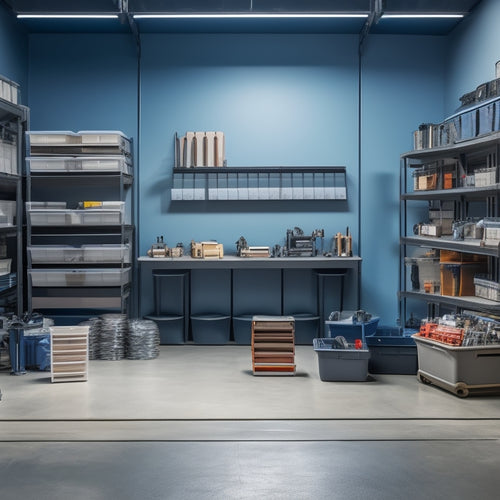
Revolutionizing Healthcare Workplaces: The Ultimate Guide
Share
You're on the frontlines of a healthcare system where wasted time, resources, and energy are compromising patient care and your organization's competitiveness. It's time to revolutionize your workplace by eliminating waste, standardizing work design principles, and implementing 5S strategies to streamline processes and refocus on high-quality care. You can also accelerate changeovers, optimize resources, and foster a culture of continuous improvement through Kaizen. By applying these principles, you'll reduce waste, boost productivity, and improve patient satisfaction. Now, discover how to take the next step in transforming your healthcare workplace into a lean, efficient, and patient-centric environment.
Key Takeaways
• Eliminate waste in healthcare by identifying and removing unnecessary processes to reduce costs and allocate resources effectively.
• Standardize work design principles to guarantee consistency, reduce variability, and optimize process flow for improved patient care.
• Implement the 5S methodology to sort, set in order, shine, standardize, and sustain improvements in healthcare workplaces.
• Adopt fast work changeover strategies to reduce waste, increase productivity, and improve patient satisfaction by streamlining handovers and optimizing operational efficiency.
• Foster a culture of continuous improvement through Kaizen, empowering teams to drive results through small, incremental changes that enhance care quality and patient outcomes.
Eliminating Waste in Healthcare
As healthcare professionals, you're constantly seeking ways to optimize patient care, and an essential step in this journey is eliminating waste in healthcare, which not only saves resources but also improves overall quality of care.
By identifying and removing unnecessary processes, you can improve efficiency, reduce costs, and allocate resources more effectively. Waste in healthcare can take many forms, including over processing, transport, over producing, waiting, and inventory.
By streamlining processes and eliminating waste, you can refocus on providing high-quality patient care. This not only benefits your patients but also helps your organization thrive in a competitive healthcare landscape.
Standardizing Work Design Principles
You can standardize work design principles by identifying and documenting the most effective methods for performing tasks, which helps guarantee consistency and reduces variability in healthcare processes. This involves selecting subprojects, defining elements of work, and determining the best workplace arrangement and staffing levels.
By doing so, you'll optimize process flow, reduce waste, and enhance workplace efficiency. Standardized work design principles enable you to identify opportunities for process optimization, allowing you to streamline tasks and improve overall productivity.
This, in turn, leads to better patient care and enhanced workplace satisfaction. By implementing standardized work design principles, you'll be able to create a more efficient, effective, and patient-centric healthcare environment.
Implementing 5S in Healthcare
By applying the 5S methodology to healthcare facilities, you can systematically eliminate waste, optimize workflows, and create a more organized, efficient, and patient-focused environment.
The first step, 'Sort,' involves removing unnecessary items and identifying what's essential.
Next, 'Set in Order' guarantees that everything has a designated place, making it easy to find what you need when you need it.
'Shine' focuses on maintaining cleanliness and upholding a hygienic environment, which is critical in healthcare settings.
'Standardized Cleanup' schedules regular cleaning tasks to maintain the new level of cleanliness.
Finally, 'Sustain' involves creating a culture that supports and maintains the improvements made.
Fast Work Changeover Strategies
Implementing Fast Work Changeover strategies in healthcare facilities can greatly reduce waste, increase productivity, and improve patient satisfaction by minimizing downtime between procedures. By streamlining handovers, you can optimize operational efficiency and maximize the use of resources.
To achieve this, identify and eliminate non-value-added activities, simplify workflows, and standardize procedures. Implementing parallel operations and automating tasks can also markedly reduce changeover times.
By applying these strategies, you can optimize process flow, reduce wait times, and increase the quality of care. This, in turn, leads to improved patient satisfaction and better health outcomes.
Continuous Improvement Through Kaizen
Kaizen, a Japanese philosophy of continuous improvement, is essential in healthcare settings where small, incremental changes can add up to significant enhancements in patient care and operational efficiency. By adopting Kaizen, you can empower your team to identify areas for improvement and implement changes that drive results. This approach encourages team engagement, fosters a culture of continuous learning, and promotes process optimization.
Here are three ways Kaizen can benefit your healthcare organization:
-
Improved patient outcomes: Kaizen's focus on continuous improvement leads to enhanced patient care and better health outcomes.
-
Increased efficiency: By streamlining processes and eliminating waste, Kaizen helps reduce costs and optimize resource allocation.
-
Enhanced team morale: Kaizen's emphasis on team engagement and empowerment boosts morale, leading to a more motivated and productive workforce.
Thinking Lean in Healthcare
As you aim to empower your team through continuous improvement, you're likely wondering how to cultivate a Lean mindset that drives meaningful change in your healthcare organization.
Thinking Lean in healthcare involves understanding value, value stream, flow, pull, and perfection. It's about focusing on what customers want and are willing to pay for, and eliminating waste that doesn't contribute to customer satisfaction.
Process optimization is key, as it enables you to identify and eliminate waste, maximize value, and improve customer satisfaction. By adopting a Lean mindset, you can create a culture of continuous improvement, where your team is empowered to identify areas for improvement and optimize processes to deliver high-quality care.
Lean Principles in Action
By applying Lean principles, you can transform your healthcare organization into a high-performing system that delivers exceptional patient care and achieves operational excellence. This is accomplished by streamlining processes, eliminating waste, and optimizing resources. You'll be able to improve workplace efficiency, reduce errors, and enhance the overall patient experience.
Here are three key areas to focus on when implementing Lean principles:
-
Standardized Work Design: Establish clear procedures and protocols to guarantee consistency and efficiency in daily operations.
-
Continuous Improvement and Kaizen: Encourage a culture of ongoing improvement, where employees are empowered to identify areas for improvement and implement changes.
-
5S: Implement a systematic approach to organizing and maintaining a clutter-free workspace, reducing waste and improving productivity.
Value Stream Mapping Essentials
You'll use value stream mapping to visualize and analyze the flow of materials and information across your healthcare organization, identifying opportunities to eliminate waste, reduce variability, and improve overall efficiency.
By creating a detailed map of your current value stream, you'll gain a deeper understanding of the flow of processes, identifying areas where waste and inefficiencies exist. This essential step in process optimization enables you to streamline workflows, reducing unnecessary steps and improving the overall patient experience.
Through workflow visualization, you'll be able to identify opportunities for improvement, optimizing the flow of materials and information to create a more efficient and effective healthcare organization.
Achieving Flow in Healthcare
To achieve flow in healthcare, focus on breaking the batch-and-queue mindset that often plagues traditional healthcare processes, and instead, design your workflows to create a seamless, continuous flow of value to patients.
This requires shifting from a focus on individual tasks to a focus on the overall value stream. By optimizing workflows, you can eliminate waste, reduce wait times, and improve patient satisfaction.
Here are three key strategies to achieve flow in healthcare:
-
Streamline workflows: Eliminate unnecessary steps and optimize the sequence of tasks to create a smooth flow of value.
-
Implement flexible work practices: Allow staff to adapt to changing patient needs and volumes to maintain a consistent flow of care.
-
Monitor and adjust: Continuously monitor workflows and make adjustments as needed to guarantee that the flow of value to patients is maintained.
Managing Constraints in Healthcare
As you work to achieve flow in healthcare, you'll inevitably encounter constraints that limit the throughput of your value stream, and it's here that managing these constraints becomes essential to maintaining a consistent flow of value to patients.
Constraints can be anything from equipment capacity to staffing levels, and they determine the output capacity of your value stream. To improve efficiency, you need to focus on optimizing resources at these constraint points. This means ensuring that you have the right people, equipment, and processes in place to maximize throughput.
Frequently Asked Questions
How Do I Measure the Effectiveness of Lean Initiatives in Healthcare?
To measure the effectiveness of lean initiatives in healthcare, you'll need to track key performance indicators using data analytics, focusing on metrics like return on investment, patient satisfaction, and process efficiency to quantify the impact of your lean efforts.
What Are the Most Common Obstacles to Lean Implementation in Healthcare?
Implementing Lean in healthcare is like trying to steer a ship through treacherous waters - you'll encounter obstacles. You'll face change resistance from employees who fear the unknown, and cultural barriers that hinder adoption of new processes and mindsets.
Can Lean Principles Be Applied to Healthcare Management Roles?
You can apply lean principles to healthcare management roles by securing leadership buy-in and empowering staff to drive process improvements, fostering a culture of continuous learning and innovation.
How Do I Balance Lean Efficiency With Patient-Centered Care?
You balance lean efficiency with patient-centered care by prioritizing compassion, empowering staff to make decisions, and streamlining processes that enhance the patient experience, ensuring that efficiency improvements never compromise care quality.
What Are the Biggest Myths About Lean in Healthcare That Need to Be Debunked?
You're about to debunk the biggest myths about Lean in healthcare, starting with the idea that Lean is only about cutting costs, not about improving patient care, and that cultural barriers will prevent successful implementation.
Related Posts
-

Custom Pegboard Storage for Your Workshop
You're looking to create a custom pegboard storage system that maximizes your workshop's space, enhances productivity...
-

How to Maximize Storage Space With Parts Storage Bins
To maximize storage space with parts storage bins, start by evaluating your available storage space and examining you...
-

What Are the Advantages of a Wooden Tool Box
You choose a wooden tool box, you're not only getting a reliable storage solution, but also a long list of benefits t...


